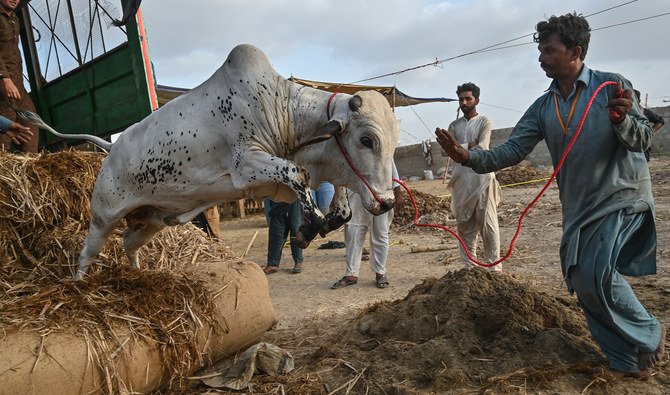KARACHI – June 8, 2025: Despite Pakistan’s deepening economic crisis, more than 7 million animals were sacrificed across the country this Eid-ul-Adha. However, the celebrations were visibly muted for many, as steep inflation and skyrocketing prices of sacrificial animals made it difficult for millions of citizens—especially from the middle and lower-income groups—to afford the ritual.
According to market sources, the prices of small animals (goats and sheep) rose by an average of Rs24,000, while large animals (cows and bulls) saw an increase of Rs70,000 ($251.80) compared to last year. An average-sized cow at Karachi’s Sohrab Goth market, the country’s largest cattle bazaar, reached up to Rs330,000 ($1,201)—almost double last year’s price.
“The price trend is very high, almost double from last year,” said Abdul Jabbar, a buyer who ultimately opted out of purchasing.
“I can’t afford it this time,” added Nasir Khan, 25, who had been part of a seven-member group pooling funds for Qurbani for several years.
Economic Pressures and Meat Exports Behind Price Surge
Economists and livestock traders have cited record meat exports and inflationary pressures as key reasons behind the price hike. In the fiscal year 2023–24, Pakistan’s meat exports hit $512 million, up 20% from the previous year. Export volumes also increased by 24%, with major destinations including GCC countries, China, Vietnam, and Afghanistan.
“The price hike is due to meat exports and inflation in previous years,” said Ahsan Mehanti, CEO of Arif Habib Commodities Ltd. “Livestock exports have increased by more than 50% in three years.”
This export boom has reduced domestic availability of cattle, leading to constrained supply at a time of peak seasonal demand, further intensifying market pressure.
Livestock Losses from Floods Also a Factor
The devastating floods of 2022, which wiped out over 1.1 million animals, have also impacted overall livestock availability. According to Sohrab Goth market spokesperson Zaki Abro, this has been a significant contributor to the limited supply in 2025.
“On average, small animals cost Rs20,000 more, and big animals are up by Rs70,000,” Abro said.
Market Dull Despite Eid Rush
Despite more than 175,000 animals being available for sale at the expansive 1,200-acre Sohrab Goth market, traders reported low buyer turnout. Livestock merchants Muhammad Ismail and Obaidullah said many animals remained unsold even as Eid approached.
“This year the market is dull,” Ismail said. “Last year, everything was sold out by this time.”
Traders blamed higher costs of animal feed (which increased by 50%), increased farming costs, market fees, and broader inflation. The cost to rear a single animal over 8–9 months rose from Rs150,000 to Rs250,000.
Additionally, sellers paid Rs30,000 per animal as a market entry fee.
Middle Class Left Behind
As a result of the price surge, many middle-class families, once active participants in this Islamic tradition, were left out this year. The average price of a goat reached between Rs85,000 to Rs150,000, making it unaffordable for many.
A growing trend was observed where people preferred joining shares in large animals, typically costing Rs25,000–32,000 per share, instead of buying individual goats.
This year, in a rare instance, there were more butchers than buyers in certain areas. Some butchers even offered door-to-door services looking for customers with smaller animals, indicating a sharp drop in household-level sacrifices.
A Bleak Backdrop for a Sacred Ritual
While millions of Pakistanis observed Sunnat-e-Ibrahimi, the economic backdrop was far from celebratory. With over 45% of the population living below the poverty line, sacrificial rituals were replaced for many by mere attendance at Eid prayers.
READ MORE: Millions of Muslims celebrate Eid al-Adha worldwide as Hajj attendance drops to 30-Year low
As food prices drop modestly and headline inflation fell to 3.5% in May 2025, sacrificial animal prices remain disconnected from broader economic trends, driven largely by export pressures, supply chain issues, and policy gaps in livestock management.
Meanwhile, the ruling elite remains focused on increasing privileges, with raises in salaries for ministers and public officials, massive spending on government advertisements, and little attention to widespread economic hardship.
Translation Excerpt (Urdu):
“آج کروڑوں پاکستانیوں نے سنتِ ابراہیمی ادا کی، لیکن مہنگائی نے اس بار سفید پوش طبقے کو قربانی سے دور رکھا۔ بکرے کی قیمت 85,000 سے ڈیڑھ لاکھ تک جا پہنچی۔ اب مڈل کلاس کے لیے قربانی مشکل ہو چکی ہے، اور بڑے جانور میں حصہ ڈالنے کا رجحان تیزی سے بڑھ رہا ہے۔ جب اشرافیہ مراعات لے رہی ہو اور عام آدمی قربانی سے محروم ہو تو سوال بنتا ہے: قربانی کا اصل مفہوم کہاں گیا؟”
By Media Bites News Desk – For www.mediabites.com.pk | June 2025


